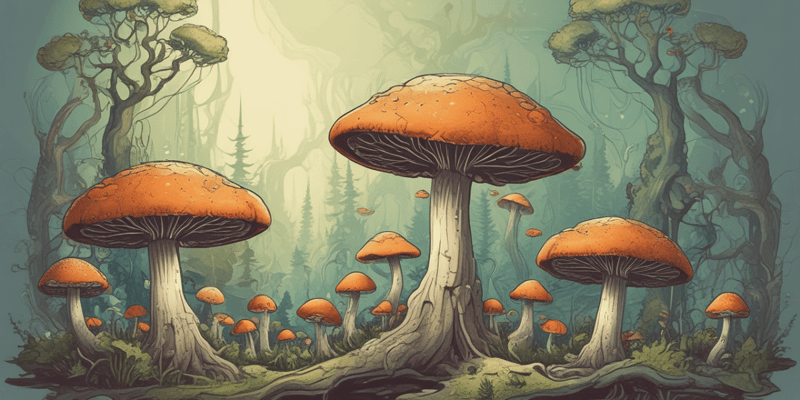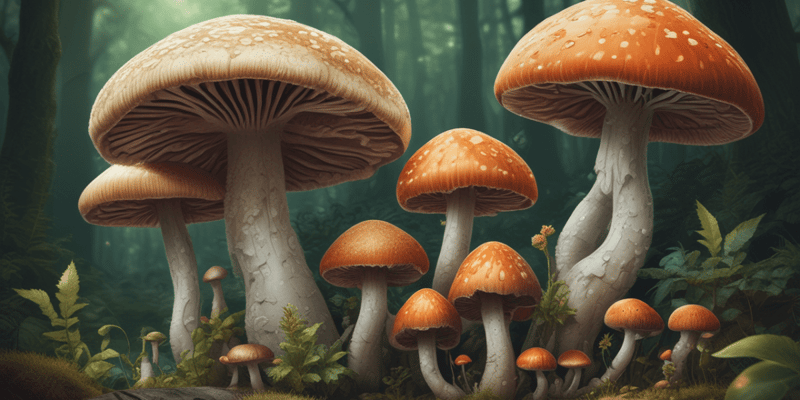32 Questions
What is the primary source of nutrition for fungi?
Dead organic matter
What is the current classification of fungi?
As their own kingdom, Mycota
How many fungal species have pathogenic potential for humans?
Around 100
What is the term for fungal diseases?
Mycoses
What is the classification of fungal infections that penetrate significantly beneath the skin?
Subcutaneous
What is a characteristic that distinguishes fungi from other infectious organisms?
They are eukaryotic
What are fungal spores known to cause?
Allergies
Why are some fungal species opportunistic?
Because they infect primarily individuals with predisposing conditions
What are two conditions that affect the choice of morphology?
Temperature and carbon dioxide levels
What is the primary means of reproduction and spread of fungi in the environment?
Sporulation
What is the characteristic of fungal spores?
Metabolically dormant and protected
How are asexual spores (conidia) formed?
By mitosis in or on specialized hyphae
What is the primary purpose of the characteristic shape and surface ornamentation pattern of spores?
Species identification
What is the standard medium used for fungal culture?
Sabouraud dextrose agar
What are the common sources of clinical samples for fungal cultures?
Pus, blood, spinal fluid, sputum, tissue biopsies, or skin scrapings
What is the purpose of adding antibacterial antibiotics to the fungal culture medium?
To inhibit bacterial growth
What is the main component of the fungal cell wall?
Chitin
Why are fungi unaffected by antibacterial antibiotics such as penicillin?
Because they have a different cell wall composition
What is the function of degradative enzymes secreted by fungi?
To break down organic matter
What is the natural habitat of almost all fungi?
Soil or water containing decaying organic matter
What is the mechanism of action of amphotericin B and nystatin?
They form pores that disrupt membrane function
What is the target of imidazole antifungal drugs?
C-14 α-demethylase
What is the function of ergosterol in fungal cells?
It is a vital component of the cell membrane
What is the mode of nutrition of fungi?
Heterotrophic
What is the primary source of most parasitic fungal infections in humans?
Contact with fungus-infested soil
Which type of fungal growth is characterized by a mass of branching threads?
Filamentous fungi
What is the term for the vegetative body of a fungus?
Thallus
Which type of fungal cell is typically partitioned into segments?
Septate hyphae
What is the term for the densely packed hyphal filaments that resemble a cohesive tissue?
Tissue-like mycelium
Which type of fungal reproduction involves the formation of new cells from the parent cell?
Budding
What is the term for fungi that can switch between two forms in response to environmental conditions?
Dimorphic fungi
Which fungal species are typically yeast-like in one environment and mold-like in another?
Systemic mycoses
Study Notes
Characteristics of Fungi
- Fungi are eukaryotic organisms that derive nourishment from dead organic matter (saprophytic) or are parasitic
- They are now assigned their own kingdom, Mycota
- Virtually all organisms are subject to fungal infection
- Only about 100 of the 100,000 fungal species have pathogenic potential for humans
Human Fungal Diseases (Mycoses)
- Classified by location on or in the body where the infection occurs
- Cutaneous: limited to the epidermis
- Subcutaneous: infection penetrates beneath the skin
- Systemic: deep within the body or disseminated to internal organs
- Systemic mycoses can be divided into:
- True pathogenic fungi: infect healthy individuals
- Opportunistic fungi: infect individuals with predisposing conditions (immunodeficiency, diabetes, leukemia, etc.)
Fungal Metabolic Products and Allergens
- Fungi produce and secrete unusual metabolic products that can be toxic to animals, including humans
- Fungal spores are important allergenic agents
Characteristics of Major Fungal Groups
- Cell wall composed of chitin, rather than peptidoglycan found in bacteria
- Cell membrane contains ergosterol, rather than cholesterol found in mammalian membranes
- Fungi are unaffected by antibacterial antibiotics that inhibit peptidoglycan synthesis
- Chemotherapeutic agents target fungal membrane synthesis or function, such as amphotericin B and nystatin
Habitat and Nutrition
- Fungi are heterotrophs, requiring preformed organic carbon source for growth
- Fungi secrete degradative enzymes to obtain soluble nutrients from their environment
- Natural habitat of almost all fungi is soil or water containing decaying organic matter
- Some fungi can be parasitic on living organisms
Modes of Fungal Growth
- Fungi exist in two basic morphologic forms: filamentous mold or unicellular yeast
- Dimorphic fungi switch between these two forms in response to environmental conditions
- Filamentous fungi have a mass of branched threads (mycelium) that grows by branching and tip elongation
- Yeast-like fungi exist as populations of single, unconnected, spheroid cells that reproduce by budding
Sporulation
- Sporulation is the principal means by which fungi reproduce and spread through the environment
- Fungal spores are metabolically dormant, protected cells that can be borne by air or water to new sites
- Spores can be generated either asexually or sexually
- Asexual sporulation: conidia are formed by mitosis in or on specialized hyphae
- Sexual sporulation: initiated by fusion of haploid nuclei from two compatible strains, producing ascospores
Laboratory Identification
- Most fungi can be propagated on nutrient agar surfaces, such as Sabouraud dextrose agar
- Cultures can be started from spores or hyphal fragments
- Clinical samples may include pus, blood, spinal fluid, sputum, tissue biopsies, or skin scrapings
Learn about the diverse group of eukaryotic organisms known as fungi, including their characteristics and role in nature and human health.
Make Your Own Quizzes and Flashcards
Convert your notes into interactive study material.
Get started for free



